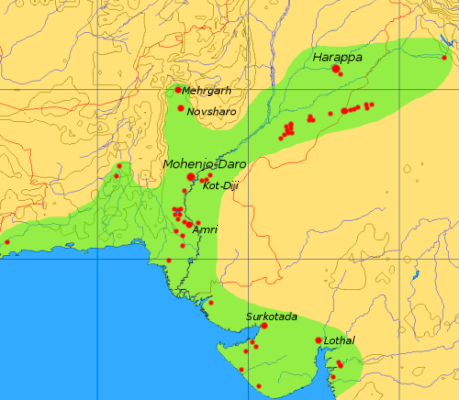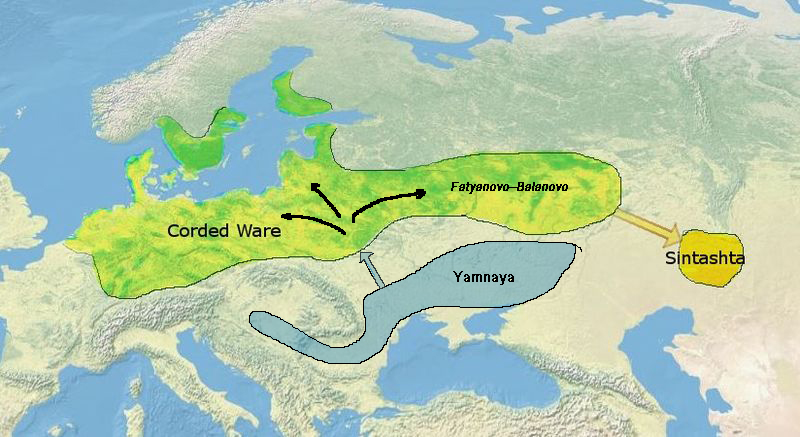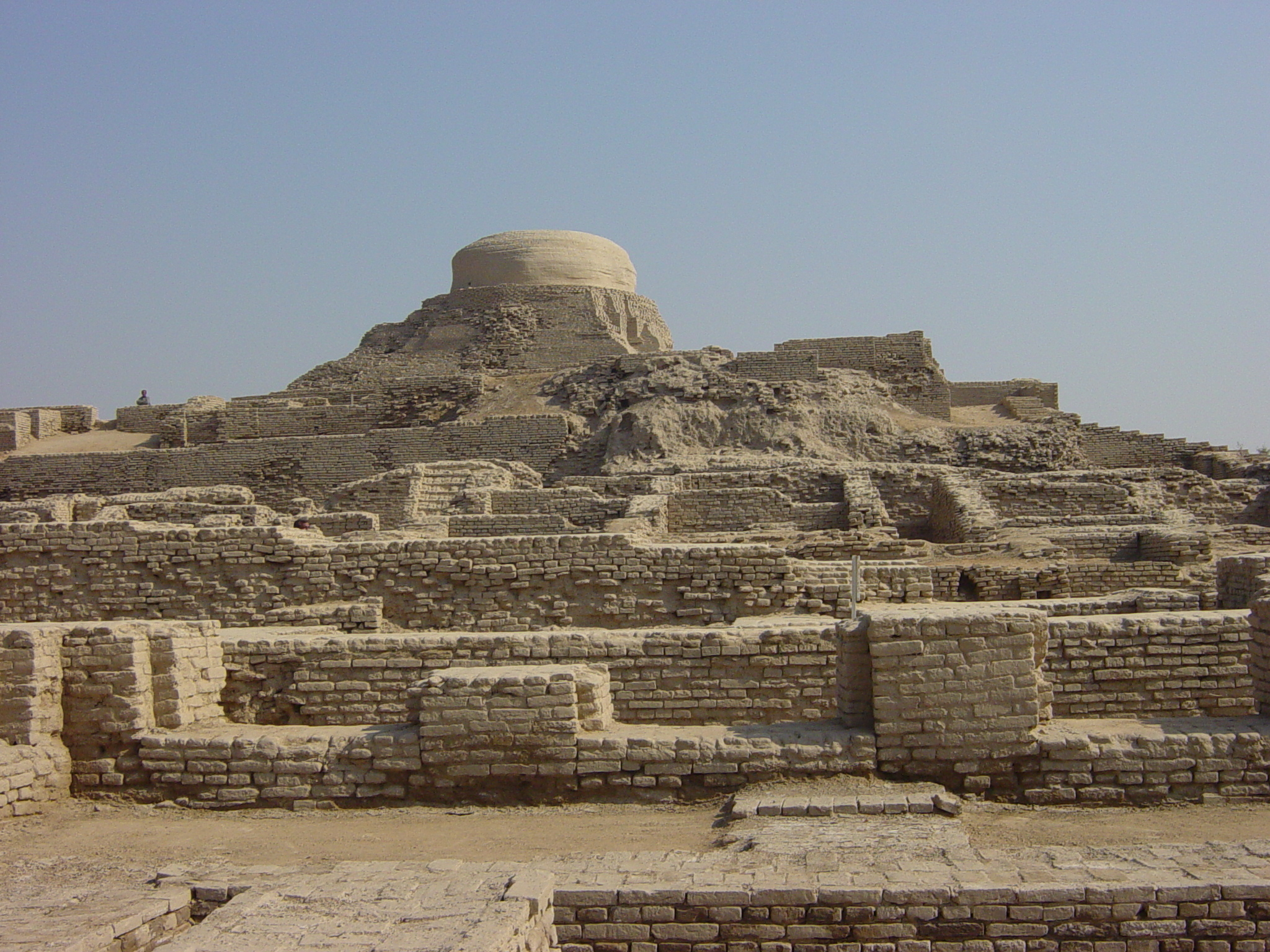|
Surkotada
Surkotada is an archaeological site located in Rapar Taluka of Kutch district, Gujarat, India which belongs to the Indus Valley civilisation (IVC). It is a smaller fortified IVC site with in area. Location and environment The site at Surkotada is located north-east of Bhuj, in the district of Kutch, Gujarat. The ancient mound stands surrounded by an undulating rising ground clustered by small sandstone hills. These hills are covered with red laterite soil giving the entire region a reddish-brown colour. The vegetation is scarce and consists of cactus, small babul and pilu trees and thorny shrubs. These give green patches to the red environment. The mound was discovered in 1964 by J. P. Joshi of the Archaeological Survey of India. The mound is higher on the western side and lower on the eastern side and has an average height of . In the ancient days, a river 750 m (½ mi) wide flowed past the north-eastern side of the site. This river, which emptied into the Littl ... [...More Info...] [...Related Items...] OR: [Wikipedia] [Google] [Baidu] |
History Of Gujarat
The history of Gujarat began with Stone Age settlements followed by Chalcolithic and Bronze Age settlements like Indus Valley Civilisation. Gujarat's coastal cities, chiefly Bharuch, served as ports and trading centers in the Nanda Empire, Nanda, Maurya Empire, Maurya, Satavahana dynasty, Satavahana and Gupta Empire, Gupta empires as well as during the Western Kshatrapas period. After the fall of the Gupta empire in the 6th century, Gujarat flourished as an independent Hindu-Buddhist state. The Maitraka dynasty, descended from a general of the Gupta empire, ruled the Kingdom of Valabhi the 6th to the 8th centuries, although they were ruled briefly by Harsha during the 7th century. The Arab rulers of Sindh sacked Vallabhi in 770, bringing the Kingdom of Valabhi to an end. In 775, the first Parsi people, Parsi (Zoroastrian) refugees arrived in Gujarat from Greater Iran. Following the fragmentation of Gujarat into numerous principalities during the ninth century, the Chaulukya dynas ... [...More Info...] [...Related Items...] OR: [Wikipedia] [Google] [Baidu] |
Indus Valley Civilisation Sites
The Indus ( ) is a transboundary river of Asia and a trans- Himalayan river of South and Central Asia. The river rises in mountain springs northeast of Mount Kailash in the Western Tibet region of China, flows northwest through the disputed Kashmir region, first through the Indian-administered Ladakh, and then the Pakistani administered Gilgit Baltistan, Quote: "Kashmir, region of the northwestern Indian subcontinent. It is bounded by the Uygur Autonomous Region of Xinjiang to the northeast and the Tibet Autonomous Region to the east (both parts of China), by the Indian states of Himachal Pradesh and Punjab to the south, by Pakistan to the west, and by Afghanistan to the northwest. The northern and western portions are administered by Pakistan and comprise three areas: Azad Kashmir, Gilgit, and Baltistan, ... The southern and southeastern portions constitute the Indian state of Jammu and Kashmir. The Indian- and Pakistani-administered portions are divided by a "line of c ... [...More Info...] [...Related Items...] OR: [Wikipedia] [Google] [Baidu] |
Indus Valley Civilisation
The Indus Valley Civilisation (IVC), also known as the Indus Civilisation, was a Bronze Age civilisation in the Northwestern South Asia, northwestern regions of South Asia, lasting from 3300 Common Era, BCE to 1300 BCE, and in its mature form from 2600 BCE to 1900 BCE. Together with ancient Egypt and Mesopotamia, it was one of three early civilisations of the Near East and South Asia, and of the three, the most widespread, its sites spanning an area including much of Pakistan, Northwest India, northwestern India and northeast Afghanistan. The civilisation flourished both in the alluvial plain of the Indus River, which flows through the length of Pakistan, and along a system of perennial monsoon-fed rivers that once coursed in the vicinity of the Ghaggar-Hakra River, Ghaggar-Hakra, a seasonal river in northwest India and eastern Pakistan. The term ''Harappan'' is sometimes applied to the Indus Civilisation after its type site Harappa, the first to be exc ... [...More Info...] [...Related Items...] OR: [Wikipedia] [Google] [Baidu] |
List Of Indus Valley Civilization Sites
The Indus Valley Civilisation (IVC), also known as the Harappan Civilisation, was a major early civilisation, existing from 3300–1300 BCE. It covered much of modern-day Pakistan and northwest India, as well as possessing at least one trading colony in northeast Afghanistan. Over 1000 Indus Valley civilisation sites have been discovered. Only 40 sites on the Indus valley were known in the pre-Partition of India, Partition era by Archaeological Survey of India, archaeologists. The most widely known Indus Valley sites are Mohenjo-daro and Harappa; Mohenjo-daro is located in modern-day Sindh, while Harappa is in Punjab, Pakistan, West Punjab. More than 90% of the Indus script, inscribed objects and seals that were discovered were found at ancient urban centres along the Indus river in Pakistan, mainly in Harappa and Mohenjo-daro.Upinder Singh, 2008''A History of Ancient and Early Medieval India From the Stone Age to the 12th Century'' p. 169 More than 50 IVC burial sites have bee ... [...More Info...] [...Related Items...] OR: [Wikipedia] [Google] [Baidu] |
Indus Valley Civilization
The Indus Valley Civilisation (IVC), also known as the Indus Civilisation, was a Bronze Age civilisation in the northwestern regions of South Asia, lasting from 3300 BCE to 1300 BCE, and in its mature form from 2600 BCE to 1900 BCE. Together with ancient Egypt and Mesopotamia, it was one of three early civilisations of the Near East and South Asia, and of the three, the most widespread, its sites spanning an area including much of Pakistan, northwestern India and northeast Afghanistan. The civilisation flourished both in the alluvial plain of the Indus River, which flows through the length of Pakistan, and along a system of perennial monsoon-fed rivers that once coursed in the vicinity of the Ghaggar-Hakra, a seasonal river in northwest India and eastern Pakistan. The term ''Harappan'' is sometimes applied to the Indus Civilisation after its type site Harappa, the first to be excavated early in the 20th century in what was then the Punjab ... [...More Info...] [...Related Items...] OR: [Wikipedia] [Google] [Baidu] |
Indigenous Aryanism
Indigenous Aryanism, also known as the Indigenous Aryans theory (IAT) and the Out of India theory (OIT), is the conviction that the Aryans are indigenous to the Indian subcontinent, and that the Indo-European languages radiated out from a homeland in India into their present locations. It is a " religio-nationalistic" view of Indian history, and propagated as an alternative to the established migration model, which considers the Pontic–Caspian steppe to be the area of origin of the Indo-European languages. Reflecting traditional Indian views based on the Puranic chronology, indigenists propose an older date than is generally accepted for the Vedic period, and argue that the Indus Valley civilisation was a Vedic civilization. In this view, "the Indian civilization must be viewed as an unbroken tradition that goes back to the earliest period of the Sindhu-Sarasvati (or Indus) tradition (7000 or 8000 BCE)." Support for the IAT mostly exists among a subset of Indian sc ... [...More Info...] [...Related Items...] OR: [Wikipedia] [Google] [Baidu] |
Onager
The onager (, ) (''Equus hemionus''), also known as hemione or Asiatic wild ass, is a species of the family Equidae native to Asia. A member of the subgenus ''Asinus'', the onager was Scientific description, described and given its binomial name by German zoologist Peter Simon Pallas in 1775. Six subspecies are accepted. The onager is reddish-brown or yellowish-brown and has a broad dorsal stripe on the middle of the back. It weighs about and reaches about head-body length. It is among the Fastest animals#Mammals, fastest mammals, capable of running . The onager had a wider range from southwest and central to northern Asia including the Levant region, Arabian Peninsula, Afghanistan and Siberia; the prehistoric European wild ass subspecies ranged through Europe until the Bronze Age. During the early 20th century, it lost most of its range in the Middle East and Eastern Asia and lives today in Iran, Kazakhstan, Uzbekistan, Turkmenistan, India, Mongolia and China. It inhabits de ... [...More Info...] [...Related Items...] OR: [Wikipedia] [Google] [Baidu] |
Former Populated Places In India
A former is an object, such as a template, gauge or cutting die, which is used to form something such as a boat's hull. Typically, a former gives shape to a structure that may have complex curvature. A former may become an integral part of the finished structure, as in an aircraft fuselage, or it may be removable, being used in the construction process and then discarded or re-used. Aircraft formers Formers are used in the construction of aircraft fuselage, of which a typical fuselage has a series from the nose cone to the empennage, typically perpendicular to the longitudinal axis of the aircraft. The primary purpose of formers is to establish the shape of the fuselage and reduce the column length of stringers to prevent instability. Formers are typically attached to longerons, which support the skin of the aircraft. The "former-and-longeron" technique (also called stations and stringers) was adopted from boat construction, and was typical of light aircraft built unt ... [...More Info...] [...Related Items...] OR: [Wikipedia] [Google] [Baidu] |
Archaeological Sites In Gujarat
Archaeology or archeology is the study of human activity through the recovery and analysis of material culture. The archaeological record consists of artifacts, architecture, biofacts or ecofacts, sites, and cultural landscapes. Archaeology can be considered both a social science and a branch of the humanities. It is usually considered an independent academic discipline, but may also be classified as part of anthropology (in North America – the four-field approach), history or geography. The discipline involves surveying, excavation, and eventually analysis of data collected, to learn more about the past. In broad scope, archaeology relies on cross-disciplinary research. Archaeologists study human prehistory and history, from the development of the first stone tools at Lomekwi in East Africa 3.3 million years ago up until recent decades. Archaeology is distinct from palaeontology, which is the study of fossil remains. Archaeology is particularly important for learn ... [...More Info...] [...Related Items...] OR: [Wikipedia] [Google] [Baidu] |
Rangpur, Gujarat
Rangpur is an ancient archaeological site in Surendranagar district near Vanala on Saurashtra peninsula in Gujarat, western India. Lying on the tip between the Gulf of Khambhat and Gulf of Kutch, it belongs to the period of the Indus Valley civilization, and lies to the northwest of the larger site of Lothal. It is the type site for the Rangpur culture, a regional form of the late phase of the Indus Valley Civilization that existed in Gujarat during the 2nd millennium BCE. Excavation Rangpur culture: Based on the distinct pottery excavated here, it was identified as a separate culture or subculture.The Harappan Civilisation: Its Sub-cultures Daily Pioneer, 10 May 2018. Trail Diggings were conducted by the Archeological Survey of India (ASI) during 1 ... [...More Info...] [...Related Items...] OR: [Wikipedia] [Google] [Baidu] |
Harappa
Harappa () is an archaeological site in Punjab, Pakistan, about west of Sahiwal, that takes its name from a modern village near the former course of the Ravi River, which now runs to the north. Harappa is the type site of the Bronze Age Indus Valley Civilisation ("IVC"), as it was the first IVC site to be excavated by the Archaeological Survey of India during the British Raj, although its significance did not become manifest until the discovery of Mohenjo-daro some years later. For this reason, IVC is sometimes called the "Harappan civilisation," a term more commonly used by the Archaeological Survey of India after decolonization in 1947. The discovery of Harappa and, soon afterwards, Mohenjo-Daro, two major urban settlements of IVC, was the culmination of work that had begun after the founding of the Archaeological Survey of India in 1861. The city of Harappa is believed to have had as many as 23,500 residents and occupied about with clay brick houses at its greatest extent ... [...More Info...] [...Related Items...] OR: [Wikipedia] [Google] [Baidu] |
Mohenjadaro
Mohenjo-daro (; , ; ) is an archaeological site in Larkana District, Sindh, Pakistan. Built 2500 BCE, it was one of the largest settlements of the ancient Indus Valley Civilisation, and one of the world's earliest major cities, contemporaneous with the civilisations of ancient Egypt, Mesopotamia, Minoan Crete, and Norte Chico.Mohenjo-Daro (archaeological site, Pakistan) on Encyclopedia Britannica website Retrieved 25 November 2019 With an estimated population of at least 40,000 people, Mohenjo-daro prospered for several centuries, but by 1700 BCE had been abandoned, along with other large cities of the Indus Valley Civilisation. The site was rediscovered in the 1920s. Significant excavation has since been conducted at the site of the city, which ... [...More Info...] [...Related Items...] OR: [Wikipedia] [Google] [Baidu] |









